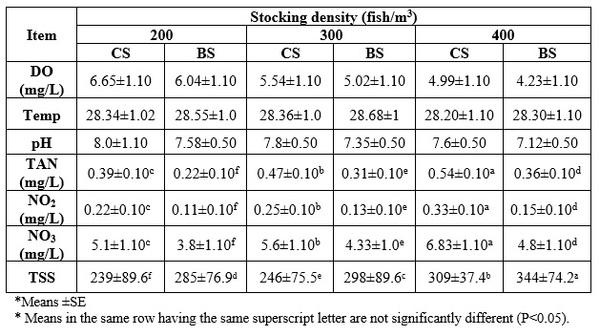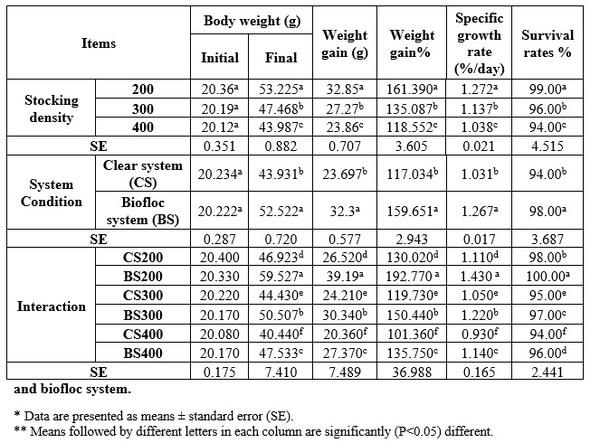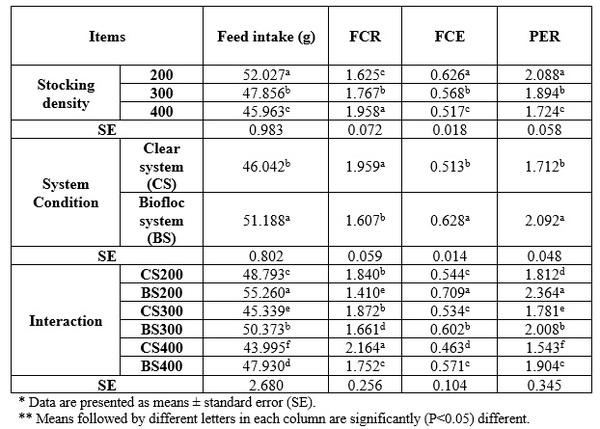Stocking density, survival rate and growth performance feed utilization and economic evaluation of Litopenaeus vannamei (Boon, 1931) in different cultured shrimp farms in Suez Canal Region
INTRODUCTION




Abdel-Tawwab M. (2012). Effects of dietary protein levels and rearing density on growth performance and stress response of Nile tilapia, (Oreochromis niloticus L.) International Aquatic Research, 4(3):1-13.
Alemu K. (2003). The growth performance of Oreochromis niloticus reared in freshwater ponds loaded with varying levels of poultry manure. SINET: Ethiopia Journal of Science 26,17:23.
American Public Health Association (APHA), 1992. Standard methods for the examination of water and waste water. 18th edition, American Public Health Association, Washington DC., 1268 pp.
AOAC. (1995). Official methods of analysis. 15th edition, Association of Official Analytical Chemists, Arlington, VA, pp. 1-45.
Avnimelech Y. (1999). Carbon/nitrogen ratio as a control element in aquaculture systems. Aquaculture, 176:227–235.
Avnimelech Y. (2007). Feeding with microbial flocs by tilapia in minimal discharge bioflocs technology ponds. Aquaculture, 264: 140-147.
Avnimelech Y. and Kochba M. (2009). Evaluation of nitrogen uptake and excretion by tilapiain bio floc tanks, using 15N tracing. Aquaculture 287, 163–168.
Avnimelech Y. and Ritvo G. (2003). Shrimp and fish pond soils: processes and management. Aquaculture 220, 549–567.
Avnimelech Y., Kochva M. and Diab S. (1994). Development of controlled intensive aquaculture systems with a limited water exchange and adjusted carbon to nitrogen ratio. Isr J Aquac Bamidgeh 46:119–131.
Avnimelech Y., Verdegem MCJ., Kurup M. and Keshavanath P. (2008). Sustainable land-based aquaculture: rational utilization of water land and feed resources. Mediterr Aquac J 1:45-55.
Ayyat M.S., El-Marakby H.I. and Sharaf S.M. (2011). Effect of dietary protein level, stocking density, and dietary pantothenic acid supplementation rate on performance and blood components of Nile tilapia (Oreochromis niloticus) ApplAquaculture, 23:122–135.
Azim M. E. and Little D. C. (2008). The biofloc technology (BFT) in indoor tanks: water quality, biofloc composition, and growth and welfare of Nile tilapia (Oreochromis niloticus), Aquaculture, 283, pp. 29–35.
Azim M.E., Little D.C. and North B. (2007). Growth and welfare of Nile tilapia (Oreochromis niloticus) cultured in indoor tanks using biofloc technology (BFT). Aquaculture. 283(1):29-35.
Bhikajee M., and Gobin P. (1997). Effect of temperature on the feeding rate and growth of a red tilapia hybrid”. pp. 131-140. In: K. Fitzsimmons (ed.). Proceeding of theFourth International Symposium on Tilapia in Aquaculture. Orlando, Florida, USA.
Bolivar R., Jimenez E., Sugue R. and Brown C. (2006).Effect of Stocking Sizes on the Yield and Survival of Nile Tilapia (Oreochromis niloticus L.) On Grown in Ponds. Asian Fisheries:Diversi¢cation & Integration, 6th Asian Fisheries Forum,Kaoshiung, Taiwan,28pp.
Burford M.A., Thompson P.J., McIntosh R.P., Bauman R.H. and Pearson D.C. (2003). Nutrient and microbial dynamics in high-intensity, zero-exchange shrimp ponds in Belize. Aquaculture, 219:393–411.
Canario A., Condeca J., Power D. and Ingleton P. (1998).The effectsof stocking densityon growth in gilthead sea-bream, Sparus aurata (L.). Aquaculture Research 29,177:181.
Castell J.D. and Tiewes K. (Editor) (1980). Report of the EIFAC, IUNS and ICES Working Group on the standardization of Methodology in Fish Research, Hamburg, FRG,212-23 March, 1979. IFAC Tech. Pap. (3) 24.
Chang WYB. (1988) Fish production: data synthesis and model development. In: Pond dynamics/aquaculture Collaborative Research Support Program (CRSP), 6th annual administrative report. Oregon State University, Oregon, pp 41–49.
Cruz E. and Ridha M. (1991). Production of the tilapia, Oreochromis spilurus(Gunther) stocked at different densitiesin sea cages. Aquaculture 99,95:103.
De Oliveira EG., Pinheiro A.B., de Oliveira V.Q., da Silva A.R., de Moraes M.G., Rocha I.R., de Sousa R.R. and Costa F.H. (2012). Effects of stocking density on the performance of juvenile pirarucu (Arapaima gigas) in cages. Aquaculture, 370–371 pp. 96-101.
De Silva E. Da., Silva J., Ferreira F., Soares M., Soares R. and Peixoto S. (2015). Influence of stocking density on the zoo technical performance of Litopenaeus vannamei during the nursery phase in a biofloc system. bol. inst. pesca, são paulo, 41(esp.): 777 – 783.
Diana J., Lin C. and Yi Y. (1996). Timing of supplemental feeding for tilapia production. Journal of the World AquacultureSociety 27,410:419.
Duncan D. B. (1955). Multiple range and multiple F tests. Biometrics 11(1):1-42.
Ellis A. P. J., West B. J., Ryan A.M. and DeShon R. P. (2002). The use of impression management tactics in structured interviews: A function of question type? Journal of Applied Psychology, 87, 1200–1208.
El-Sayed A.F.M. (2002). Effects of stocking density and feeding levels on growth and feed efficiency of Nile tilapia (Oreochromis niloticus) fry. Aquac. Res. 33, 621 – 626.
Engle C. and Valderrama D. (2001). Effect of stocking density on production characteristics, cost and risk of producing fingerlings of channel catfish. North America Journal ofAquaculture 63, 201:207.
FAO. (2016). The state of world fisheries and aquaculture. FAO Fisheries department, fisheries information, data and statistics unit, Roma.
FAO. (2018a) The State of World Fisheries and Aquaculture 2018—meeting the sustainable development goals. License: CC BYNC-SA 3.0 IGO, Rome
Ferdous Z., Ajaz Masum M.d. and Mohsin A.M.d. (2014). Influence of Stocking Density on Growth Performance and Survival of Monosex Tilapia (Oreochromis niloticus) Fry. International Journal of Research in Fisheries and Aquaculture 2014; 4(2): 99-103.
Ferreira L.M.H., Lara G., Wasielesky W. and Abreu P.C. (2016). Biofilm versus biofloc are artificial substrates for biofilm production necessary in the BFT system? Aquac. Int. 24, 921–930.
Gaona C., Poersch L., Krummenauer D., Foes G. and Wasielesky W. (2011). The effect of solids removal on water quality, growth and survival of Litopenaeus vannamei in a biofloc technology culture system. International Journal of Recirculating Aquaculture 12: 54–73
Garcia F., Romera D.M., Gozi K.S., Onaka E.M., Fonseca F.S., Schalch S.H.C.,Can-deira P.G., Guerra L.O., Carmo F.J., Carneiro D.J., Martins M.I.E. and Portella M.C. (2013). Stocking density of Nile tilapia in cages placed in a hydroelectric reservoir. Aquaculture 410–411, 51–56.
Gibtan, A., Getahun, A., and Mengistou, S. (2008). Effect of stocking density on the growth performance and yield of Nile tilapia [Oreochromis niloticus (L., 1758)] in a cage culturesystem in Lake Kuriftu, Ethiopia. Aquaculture Research, 39(13), 1450–1460.
Hargreaves J. A. and Tucker C. S. (2004). Managing ammonia in fish pond. SRAC Publication No. 4603, 8 pp.
Haylor G.S. (1991). Controlled hatchery production of Clarias gariepinus _Burchell, 1822.: growth and survival of fry at high stocking density. Aquacult. Fish. Manage. 22, 405–422.
Jørgensen E., Christiansen J. and Jobling M. (1993). Effect of stocking density on food intake, growth performance and oxygen consumption in Arctic charr (Salvelinus alpinus). Aquaculture 110,191:204.
Khattab Y., Abdel-Tawwab M. and Ahmad M. (2004). Effect of protein level and stocking density on growth performance, survival rate, feed utilization and body composition of Nile tilapia fry (Oreochromis niloticus, L.). In: Proceeding of the 6th International Symposium on Tilapia in Aquaculture (ed. by R. Bolivar, G. Mair & K. Fitzsimmons), pp. 264:276. Manila, Philippines.
Kuhn D.D., Boardman G.D., Lawrence A.L., Marsh L. and Flick G.J. (2009). Microbial flocs generated in bioreactors is a superior replacement ingredient for fish meal or soybean meal in shrimp feed. Aquaculture, 296, 51– 57.
Labib E.H. (2016) Effect of dietary protein levels and carbohydrate sources for water media on live Food microbial protein production for Nile tilapia (Oreochromis niloticus). Mediterr. Aquac. J., 8 pp. 153-170.
Li D., Liu Z.A and Xie C. (2012). Effect of stocking density on growth and serum concentrations of thyroid hormones and cortisol in Amur sturgeon (Acipenserschrenckii). Fish physiology biochemistry 38:511-520.
Little D.C., Murray J.F., Azim M.E., Leschen W., Grady K., Young J. and Watterson A. (2008). Warm-water fish production in the UK: limits to green growth? Trends in Food Science and Technology 19, 255–264.
Liu G., Ye Z., Liu D. and Zhu S. (2018). Inorganic nitrogen control, growth, and immune physiological response of Litopenaeus vannamei (Boone, 1931) in a biofloc system and in clear water with or without commercial probiotic. Aquac. Int., 26 (4): pp. 981-999.
Lovell T. (1989). Nutrition and feeding of fish. An. AVI Book. Van Nostrand Reinhold, New York. 260 pp.
Luo G., Gao Q., Wang C., Liu W., Sun D., Li L. and Tan H. (2014). Growth, digestive activity, welfare, and partial cost effectiveness ofgenetically improved farmed tilapia (Oreochromis niloticus) cultured in a recirculating aquaculture system and an indoorbiofloc system. Aquaculture 422:1–7.
Mansour A.T. and Esteban M. (2017a). Effects of carbon sources and plant protein level in a biofloc system on growth performance, and the immune and antioxidant status of Nile tilapia (Oreochromis niloticus). Fish Shellfish Immunol. 64, 202–209.
Mansour A.T. and Esteban M. (2017b). Effects of carbon sources and plant protein levels in a biofloc system on growth performance, and the immune and antioxidant status of Nile tilapia (Oreochromis niloticus). Fish Shellfish Immunol. 64, 202–209.
Marti´nez-Porchas M., Marti´nez-Co´rdova LR. and Ramos-Enriquez R. (2009). Cortisol and glucose: reliable indicators of fish stress. Pan Am J Aquat Sci 4:158–178.
Martin R. and Wertheimer A. (1989). Adult production of chinook salmon reared at different densities and released as two small sizes. Progressive Fish Culturist 51,194:200.
Moniruzzaman M., Uddin KB., Basak S., Mahmud Y., Zaher M. and Bai SC. (2015). Effects of stocking density on growth, body composition, yield and economic returns of monosex tilapia (Oreochromis niloticus L.) under cage culture system in Kaptai Lake of Bangladesh. J Aquacult Res Dev 6 (8): 1-7.
Mullin I. B. and Riley I. P. (1955). The colorimetric determination of silicate with special references to Sea and natural waters. Anal. Chem. Acta, 12: 162-176.
Nunes Caldini, N., De Holanda Cavalcante D., Rocha Filho P.R.N. and Carmo e Sa M.V. (2015). Feeding Nile tilapia with artificial diets and dried bioflocs biomass. Acta Sci.
Ouattara N., Teugels G., DoubaV. and Philippart J. (2003). Aquaculture potential of the black-chinned tilapia, Sarotherodonmelanotheron (Chiclidae): comparative study of the effectsof stocking density on growth performance of landlocked and natural populations under cage culture conditions in Lake Ayame (Cote d’Ivoire). Aquaculture Research 32,1223:1229.
Phan P. and de Siliva S. (2000). The fisheries of Ea Kao reservoir, Southern Vietnam: a fisheries based on combination of stock recapture, and self ^ recruiting population. FisheriesManagement and Ecology 7, 251:254.
Qasem A.A. (2016). Effect of Some Factors on Nile Tilapia Production Under Different Culture Conditions. Faculty of Agriculture (Saba– Basha), Alexandria University.
Rahman M.A. (2012). Water Security: Ethiopia–Egypt Transboundary Challenges over the Nile River Basin. Journal of Asian and African Studies, 48: 35-46.
Rajkumar M., Pandey P.K., Aravind R., Vennila A., Bharti V. and Purushothaman C.S. (2016). Effect of different biofloc system on water quality, biofloc composition and growth performance in Litopenaeus vannamei (Boone, 1931). Aquaculture Research, 47(11):3432–3444.
Randall D.J. and Tsui T.K.N. (2002). Ammonia toxicity in fish. Marine Poll.Bull., 45: 17-23.
Recker W.E. (1975). Computation and interpretation of biological statistics of fish population. Fish Res. Res. Board Can. Bull., 191.
Remen M., Imsland A.K., Stefansson S.O., Jonassen T.M. and Foss A. (2008). Interactiveeffects of ammonia and oxygen on growth and physiological status of juvenileAtlantic cod (Gadus morhua). Aquaculture 274, 292–299.
Robinson G., Caldwell GS., Jones CLW. and Stead SM. (2019). The effect of resource quality on the growth of Holothuria scabra duringaquaculture waste bioremediation. Aquaculture 499:101–108.
Samocha T.M., Patnaik S., Speed M., Ali A.M., Burger J.M., Almeida R.V., Ayub Z., Harisanto M., Horowitz A. and Brock D.L. (2007). Use of molasses as carbon source in limited discharge nursery and grow-out systems for Litopenaeus vannamei. Aquacultural Engineering, 36:184–191.
Siddiqui A., Howlader M. and Adam A. (1989). Culture of Nile tilapia, Oreochromis niloticus, L., at three stocking densities in outdoor concrete tanks using drainage water. Aquaculture and Fisheries Management 20,49:57.
Silva P., Souza V., Padua D., Dalacorte P. and Goncalves D. (2000).Effect of stocking density on growth and fillet composition of tetra hybrid red tilapia, Israeli strain. In: Tilapia Aquaculture in the 21st Century: Proceedings from5th International Symposium on Tilapia Aquaculture (ed. by K. Fitzsimmons & C. Filho), pp. 341–345. The world aquaculture society, FL, USA.
Sorphea S., Lundh T., Preston T.R., Borin K. (2010). Effect of stocking densities and feed supplements on the growth performance of tilapia (Oreochromis spp.) raised in ponds and in the paddy field. Livest. Res. Rural Dev. 22.
Sugunan W. and Katiha P. (2004). Impact of stocking density on yield in small reservoirs in Andra-Pradesh, India. Fisheries Managementand Ecology11,193:202.
Tadesse A. (2007).The effects of stocking density and supplementary feeding on growth performance of Nile tilapia [Oreochromis niloticus (L.,1758)] in cage culture system in Lake Elen, Ethiopia.MSc Thesis, Addis Ababa University, Ethiopia.
Timmons M.B., Ebeling J.M., Wheaton F.W., Summerfelt S.T. and B.J. Vinci (2002). Recirculating Aquaculture Systems, 2nd Ed., Cayuga AquaVentures, pp. 769.
Tolussi C.E., Hilsdorf A.W., Canneppele D. and Moreira R.G. (2010). The effect of stocking density in physiological parameters and growth of the endangered teleost specie Piabanba bryconinsignis. Aquaculture, (310), 221-228.
Wahab M.A., Berghcim A. and Braaten B. (2003). Water quality and partial mass budget in extensive shrimp ponds in Bangladesh. Aquaculture 218: 413-123.
Wasielesky W.Jr., Froes C., Fóes G., Krummenauer D., Lara G. and Poersch L. (2013). Nursery of Litopenaeus vannamei reared in a biofloc system: the effect of stocking densities and compensatory growth. Journal of Shellfish Research, 32(3), 799-806.
Watanabe W., Clark J., Dunham J., Wicklund R. and Olla B. (1990). Culture of Florida red tilapia in marine cages: Effect of stocking density and dietary protein on growth. Aquaculture 90,123:134.
Wendelaar Bonga S.E. (1997) The stress response in fish. Physiological Reviews, 77, 591–625.
Xu WJ., Pan LQ., Zhao DH. and Huang J. (2012). Preliminary investigation into the contribution of bioflocs on protein nutrition of Litopenaeus vannamei fed with different dietary protein levels in zero-water exchange culture tanks. Aquaculture 350: 147–153.
Yoo G.Y. and Lee J.Y. (2016). The effect of feeding frequency, water temperature, and stocking density on the growth of river puffer Takifugu obscurus reared in a zero exchange water system. Can. J. Fish. Aquat. Sci. 19, 23.
Zaki M.A.A., Alabssawy A.N., Nour A.E.-A.M., El Basuini M.F., Dawood M.A.O., Alkahtani S. and Abdel-Daim M.M. (2020). The impact of stocking density and dietary carbon sources on the growth, oxidative status and stress markers of Nile tilapia (Oreochromis niloticus) reared under biofloc conditions. Aquaculture Reports, 16: 1-8.
Zhao P., Huang J., Wang X. H., Song X. L., Yang C. H., Zhang X. G. and Wang G. C. (2012). The application of bioflocs technology in high-intensive, zero exchange farming systems of Marsupenaeus japonicus, Aquaculture, 354, pp. 97–106







.jpg&w=3840&q=75)